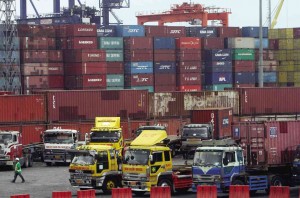MANILA, Philippines—The Port of Manila (POM) and the Manila International Container Port (MICP), two of the country’s biggest ports, are still “congested” with an undisclosed number of container vans of imported goods as a result of the Manila truck ban, according to an official of the Bureau of Customs.
Agaton Uvero, customs deputy commissioner for the Assessment and Operations Coordinating Group, however, told the Inquirer the bureau was “expecting things to slowly normalize (this) week.”
For her part, Charo Logarta-Lagamon, chief of the agency’s public information and assistance division (PIAD), reported that the POM and MICP were open last Saturday from 9 a.m. to 5 p.m.
“Unfortunately, despite the extension (of port operations), not very many filed import entries or got their cargoes,” she said.
Lagamon quoted a top MICP official as saying there were “very few customers” at the two ports.
On Thursday and Friday, the bureau extended its regular port operating hours of 9 a.m. to 5 p.m. to 9 p.m.
It also deployed additional examiners and X-ray inspection personnel to “expedite the release of cargo with paid customs and duties.”
Last Thursday, truckers’ groups resumed operations after the Manila city government agreed to a temporary concession that would allow trucks and other vehicles with a gross weight of more than 4,500 kilos to ply city streets from 10 a.m. to 3 p.m. for the next six months.
Earlier, it said the same vehicles would not be allowed on city streets from 5 a.m. to 9 p.m., seven hours longer than the previous scheme.
The move was intended to ease the traffic congestion in the country’s capital that was expected to worsen in the wake of the two major road projects launched two weeks ago.
There is no truck ban on Saturdays and Sundays. Exempted from the prohibition are trucks carrying perishables and petroleum products, as well as vehicles carrying materials intended for government projects.
In a related development, the PIAD acknowledged the government’s revenue collections had been hurt by the truck ban.
In a new release, it disclosed that from Feb. 24 to 26, the POM and MICP registered losses of P272.59 million and P217.39 million, respectively, for a total of P489.98 million.
Before the truck ban, the two ports had daily average collections of P712.9 million.
Last week, the bureau said in a statement that on the first day of the ban on Feb. 24, the release of container vans from the MICP dropped from an average of 2,150 per day to only four.
Also, the release of container vans from the POM fell from an average of 1,200 per day to none.
The BOC pointed out the drop in the release of the number of container vans had resulted in the “dramatic decline in revenue collections in the two ports.
On Feb. 24, collections at the MICP dropped by 27 percent to P262.8 million, while at the POM they fell by 47 percent to P134.4 million.
Customs Commissioner John Phillip Sevilla said the agency would find ways to address the adverse effects of the truck ban on businesses.
“While there are conditions and factors that are beyond the control of the Bureau of Customs, we are ready to adjust to the needs of importers and other stakeholders,” he added.
Originally posted: 6:31 pm | Sunday, March 2nd, 2014
RELATED STORIES
Manila truck ban pits Estrada vs business org
Firms risk losses, higher costs due to truck ban
